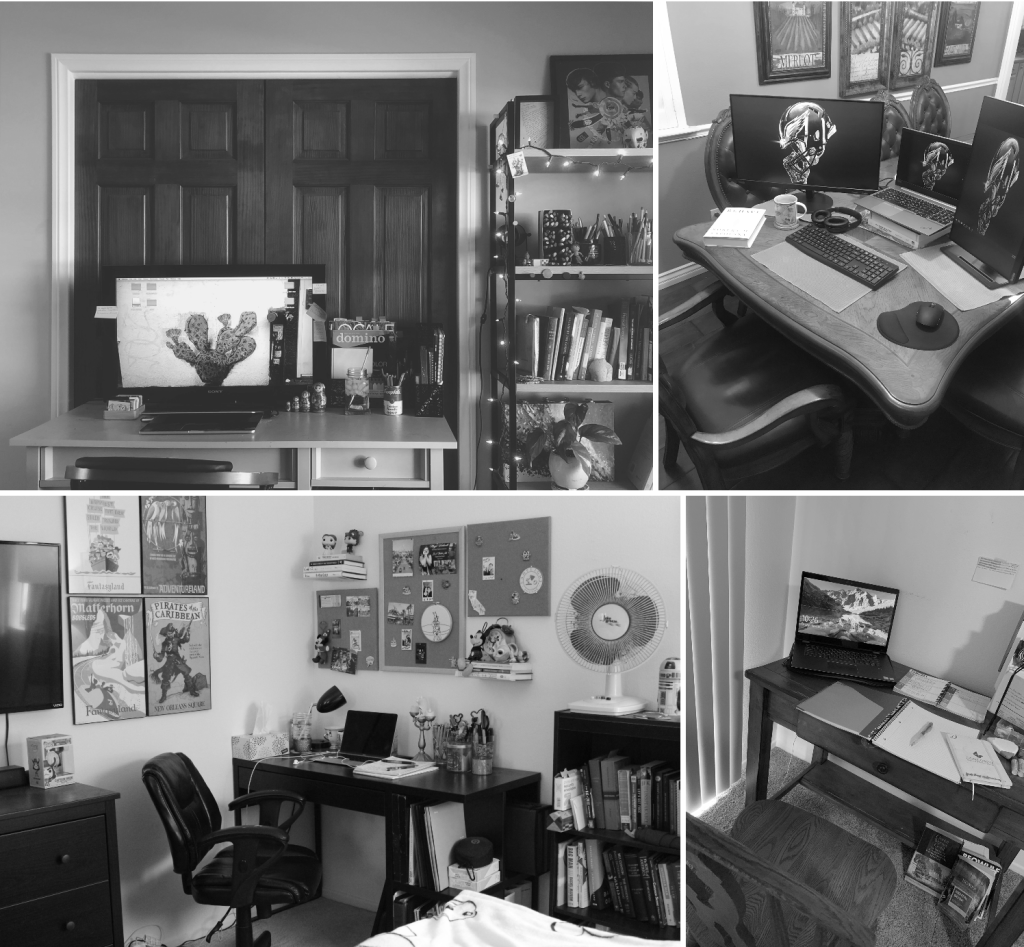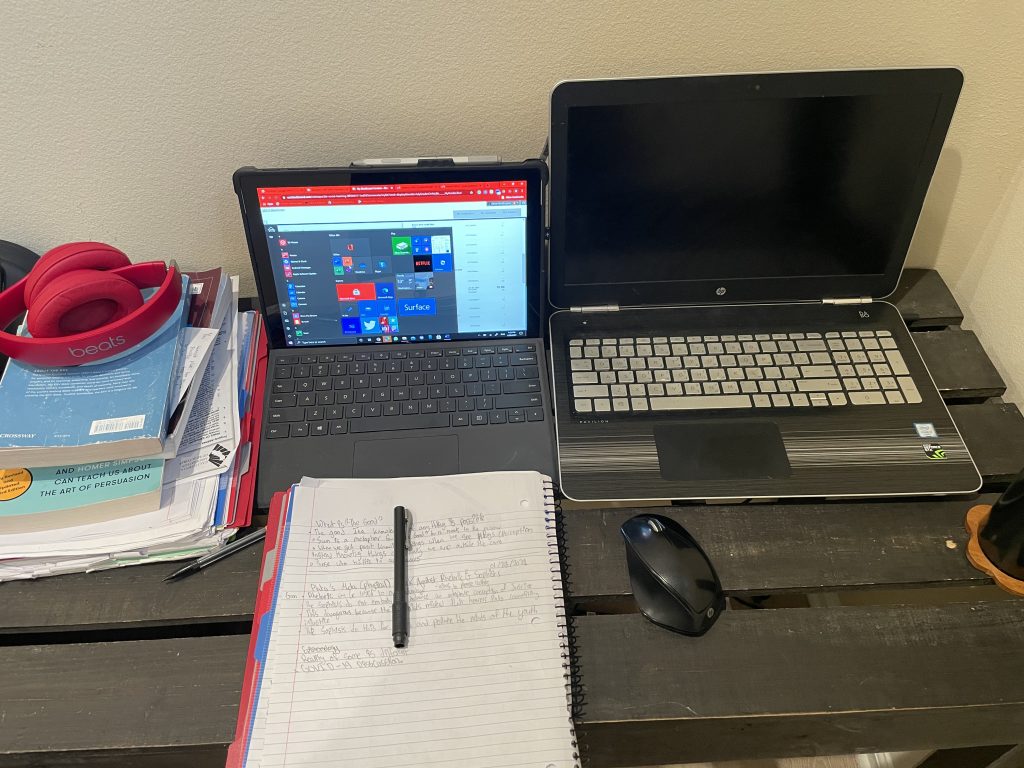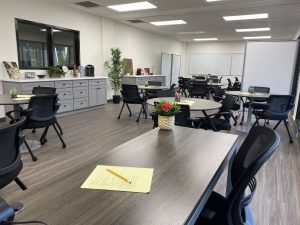3 Change of Scenery: Examining At Home Writing Spaces to Improve On-Campus Writing Centers
Makenna Myers, Kaylee De La Motte, Kirstie Skogerboe, and Seth Skogerboe
Concordia University Irvine
Introduction
Close your eyes. Picture your writing center. What catches your attention first? How do you feel walking across the threshold? What does the space say to you? The design of an on-campus writing center is its own kind of essay that nonverbally communicates values and goals through the arrangement of tables and the color of paint on the walls. We need to ask ourselves what our writing centers are communicating to students before the consultant has even said hello.
This question of writing center design may have seemed unimportant during the peak of the COVID-19 pandemic in 2020 and 2021 when most in-person writing centers were shut down and college campuses nearly empty. Instead of meeting in person, consultants and clients connected digitally in bedrooms, offices, living rooms, and backyards across the country. The Concordia University Irvine Writing Studio argued this was the time to be evaluating writing center design. This was a chance to study the writing spaces that students designed for themselves during the peak of the pandemic and, in doing so, answer the question of how we might best serve them when it was safe to reopen. Informed by student-created writing spaces during the pandemic, what actionable change can on-campus writing centers make in terms of the hospitality, functionality, and aesthetic design of their in-person space to help students and consultants succeed?

What follows is a summary of our study, a discussion of the emerging themes, and questions to consider when reimagining in-person writing center design, as well as how Concordia University Irvine’s Writing Studio has responded to this research. To view the photos submitted by students, visit https://changeofsceneryphotoessay.wordpress.com/cui/
Methods
The Concordia University Irvine Writing Studio conducted an IRB-approved study during the 2020-2021 academic year. A Google Form was sent out to all current Writing Studio clients asking them to submit a photo of their at-home writing space and complete a brief survey. Submission was voluntary, and participants consented to have their photos and comments published with their identity kept anonymous. Participants could refuse to participate or withdraw from the study at any time. By submitting a response, participants were entered into a raffle to win a gift card as an incentive.
Following the introduction and informed consent sections, the survey requested basic biographical information (name, class standing, and major). Participants were then prompted to upload a photo of their space. Photo submission tips and four example pictures were included as well. Participants were asked to complete a questionnaire about their writing space, including what they liked and disliked about their space, what they would change about it if they could, and whether or not they felt their writing had changed since working from home. The survey remained open for two weeks and collected fifteen student responses. The participants varied widely in both major and year of study. A team of undergraduate Writing Studio consultants analyzed the results and collectively discussed patterns that emerged in the findings.
Results
Each workspace photo submitted was fundamentally the same—a laptop on a desk. Yet, each was also distinct in how the student set up their space. Four main themes emerged among spaces that prove useful to improving the design of on-campus writing centers.
In their surveys, several students noted it was difficult to avoid distraction because their writing space was in a communal area of their home, such as a dining room or patio. Many students’ least favorite part about their space was this lack of privacy. One student wrote, “I wish I didn’t have to have my desk in the living room. I wish I had a room specifically for an office space to sit down with just my thoughts.” Similarly, another student mentioned, “My least favorite part is that the TV is also in the room. I have to choose another space to write in if someone wants to watch something.” More than just a lack of focus, students said that this constant distraction changed the way they write. One student explained,“I have to write earlier in the morning when everyone is either not home or asleep because it is the only time I can focus.”Another said they “…write more in short bursts, rather than long hours like before because [they] naturally get interrupted often or distracted in [their] at-home space.” Frustration about a lack of privacy and the effects of distraction on productivity were ultimately the most common themes in the responses.

Of all the elements of a workspace, art and photography were by far the most personal and sentimental to students and were found in nearly every space. Students loved how photographs and art made their space more inspiring. One student said directly, “The art on my walls gives me inspiration for writing!” Another elaborated on this concept further: “I love to look up at the impressionist paintings above me. They’re only posters, but it’s nice to see them amidst all the busyness of the day.”

Where the presence of pictures and art inspired students, the lack of it had an effect as well. One student’s least favorite part about their space “…is that it is very blank. I stare at a white wall with a single highlighted note card with my class schedule,” even adding, “I really should add some posters or drawings to liven up the vibe.”


A number of students mentioned how they liked to display their favorite quotes around their writing space to keep them both inspired and encouraged. One student said, “I love keeping motivational sticky-notes on my desk to keep my energy high throughout the day,” where another said their quotes made them feel “…safe and at peace.”
Another student specified their quote board was “…changeable, but it has been stuck on these lyrics from my favorite song for months now.” Though the presentation and effect of inspirational quotes in each space varied, the intention remained the same—students liked to keep inspiring words close by to encourage them in a time when they were often separated from the people who would be giving them that encouragement in person.

Coffee and Snacks
Perhaps unsurprisingly, many students mentioned snacks and caffeine as a key feature of their at-home writing space. One student mentioned how they enjoyed being home because they had easier access to snacks than on campus. These snacks and drinks were often kept close by, in the corners of desks or nearby drawers. One student said, “My iced coffee is always on the right because I can’t study without it.” Another student echoed that sentiment: “Coffee keeps me going throughout the day. The mug is constantly being filled—I will go through 2-3 pots of coffee a day (also an expensive and addictive habit).” Analyzing the coffee-drinking and snack-eating habits of students might seem excessive, but when a writer is physically comfortable, increased productivity is likely to follow.
How do we take these commonalities gathered from the information students have offered and reimagine them into a space that will better help both students and consultants thrive as writers in a post-pandemic world? Below is a list of questions and suggestions that have been divided into three major themes to consider when reimagining an in-person writing center—hospitality, functionality, and aesthetics.
Discussion
Hospitality
Ideally, writing centers are designed to be welcoming spaces for writers of all disciplines, skill levels, and backgrounds, but it is important to consider what a space might be saying about who is not welcome. When analyzing the hospitality of a center’s environment, it is important to first look past the physical concerns of comfortable chairs and tables. As Eric C. Camarillo writes in “Burn the House Down: Deconstructing the Writing Center as a Cozy Home,” the goal of redesigning centers should not just be about making them “…‘cozier’ but to make them more equitable.” Before redesigning the physical space, Camarillo encourages centers to critically engage with the cultural assumptions behind the purpose and mission of a writing center and who has historically been welcome and who has not; this deconstruction is one way to create a less oppressive and more authentically welcoming space.
Following critical engagement with the notion of writing centers and hospitality, consultants can look at their spaces and more equitably determine what physical comforts they can provide to help students succeed. Comfort does not necessarily refer to temperature control or chair cushions (though many students did mention uncomfortable chairs in their at-home writing space as a main complaint in their surveys). Those practical elements are often determined by university resources and are out of a center’s control. Viewing comfort through the lens of equity means the writing center should be a safe space for all students where writing is the focus. Post-pandemic, this is of paramount importance. In their surveys, students expressed how much they missed having a space dedicated to writing on campus and how their productivity and motivation suffered as a result. Here are some questions to consider in making sure that a writing center is as physically welcoming as possible to all students needing a dedicated workspace.
Questions to Consider:
- Can our center offer refreshments to students such as coffee or prepackaged snacks? The Concordia University Irvine Writing Studio added a Keurig machine in the months before the pandemic, and it has remained a popular feature of the studio since reopening.
- Is there any room to add a small waiting area for clients with comfortable chairs and a variety of reading materials?
- Is our center a quiet space for students who need to write independently? If not, is there a space we can direct them to (such as a library or a courtyard) where they can focus?
- Are the chairs students and consultants sit in comfortable? If not, could these be changed or adjusted?
Functionality
Many students mentioned in their survey that they were greatly dissatisfied with the functional elements of their at-home space, such as the size of their desk and the lack of proper electric outlets. These practical considerations for helping students succeed are often overlooked because they are fairly minor inconveniences. However, it is important to consider how the physical space of your center could be better tailored to serve students’ needs.
Questions to Consider
- Is the layout of our center easy to navigate? Can students easily move from the door to the consultation table? Is our floor space being used effectively?
- Does the space allow for zones of privacy for students to focus on their work?
- Is there any dead space that is not in use? What could be put there instead (i.e., shelf for handouts, bookcase of resources, charging station for laptops and phones, etc.)?
- Do students have access to outlets? Could our center potentially acquire different kinds of chargers if students forget their own?
- Is there adequate signage to help students find our center?
- Does our center have adequate Wi-Fi?
- Is our center accessible to those with physical disabilities?
- Does our center provide paper, pens, and pencils for students to use if they would like to take handwritten notes instead of typed ones?
- Does our center have a whiteboard to use as a teaching tool and/or a shared writing space for students and consultants?
Aesthetics
Evonne Phillips of New Zealand Tertiary College points out the importance of beauty in adult learning spaces:
In adult education, we have sometimes overlooked aesthetic sensitivities, or seen them as being too costly, too time consuming, or of little importance to the overall end result of qualifying grades—something we all want to see our students achieve. We have, perhaps, overlooked something very important, such as the power of the environment to create learning stimulations, enquiry, conversation, inspiration, and discovery.
The results of Concordia University Irvine’s survey concur with Phillips—students are more inspired to write in a space that is visually pleasing.
Questions to Consider
- What color are our center’s walls? What feeling does that color evoke in students when they walk in? A 2014 study published in the International Society for Educational Planning suggests that white walls can make students more anxious and can even decrease their productivity. Kathryn Grube suggests that painting walls a cooler color such as blue or green can provide a relaxing setting that calms students (78).
- Does our center make use of our wall space? If you have an empty wall, consider installing something functional or visually intriguing. Some options include:
- A corkboard to display inspirational quotes. Staff and students can write their favorites and pin them up to encourage other students (or make them laugh).
- A photo wall that introduces the staff. Offering staff the option to hang up their photos and a few facts about themselves could add a personal touch to the center and help clients get to know staff members they have not worked with yet. Concordia University Irvine’s Writing Studio has put up a photo wall and periodically updates the information and facts about the staff to keep it fresh.
- Utilize your university’s art department. Consider turning a blank wall into a space where art students could display their work on a rotating schedule.
- Does our center have any real or fake plants? Real plants are certainly not feasible for every space, but a bit of fake greenery may accomplish the same goal of bringing a little more life into your space.
Conclusion
The Concordia University Irvine Writing Studio was pleased to find that our space already provides many of the elements mentioned above, such as a coffee station, a soft blue and green color scheme, circular tables to promote conversation, and most importantly, a welcoming, quiet environment dedicated to writing. Nevertheless, we are still actively pursuing the inclusion of student art in our studio and have since added two more tables to our space, as well as a bookshelf with resource books for both consultants and students to access easily. Rather than seeking the perfect writing center design, we hope to let our space grow alongside our writers, always finding new and better ways to support their needs.


The look and feel of a writing space has an impact on the productivity and motivation of writers, whether that is a space they created for themselves or an on-campus writing center. As Phillips writes, “We need spaces where people are deeply respected and valued; attractive spaces which speak of the value we place on our learners’ wellbeing; spaces which are calming and yet stimulating; spaces which relax yet engage the mind. We need spaces where the informal curricular reaches out a warm inviting hand” (75). We must turn our on-campus space into our own thesis statement about the purpose of a writing center—to produce more confident and effective writers and to communicate that we as consultants are here to support and uplift them as peers and fellow writers.
Works Cited
Camarillo, Eric C. “Burn the House Down: Deconstructing the Writing Center as Cozy Home.” The Peer Review, vol. 3, no. 1, Summer 2019. https://thepeerreview-iwca.org/issues/.
Grube, Kathryn. “Detrimental Effects of White Valued Walls in Classrooms.” Educational Planning, vol. 21, no. 2, June 2013, pp. 69-82. EBSCOhost, search.ebscohost. com/login.aspx?direct=true&db=ehh&AN=96270199&site=ehost-live.
Phillips, Evonne. “Creating Beautiful Learning Spaces for Adults: How the World of the Child and the Adult Learner can Intersect.” He Kupu: The Word, vol. 2, no. 4, 2011, pp. 72-76. https://www.hekupu.ac.nz/article/creating-beautiful-learning-spaces-adults-how-world-child-and-adult-learner-can-intersect.
